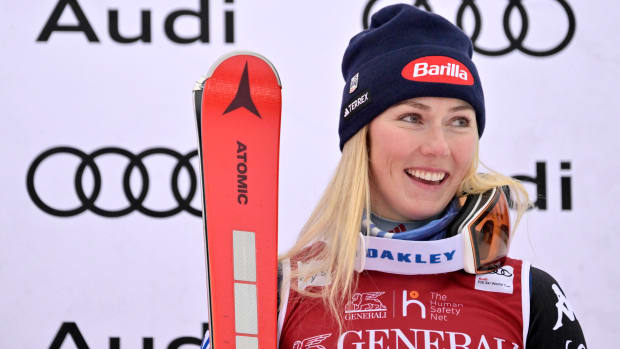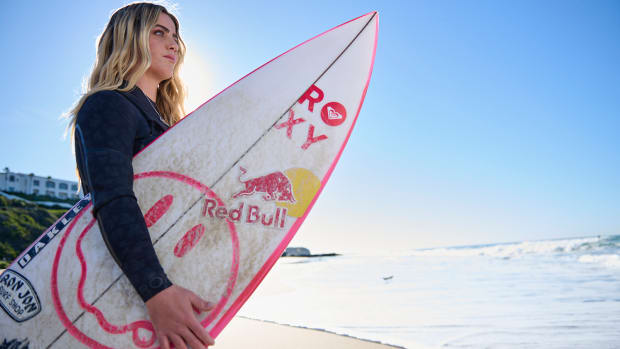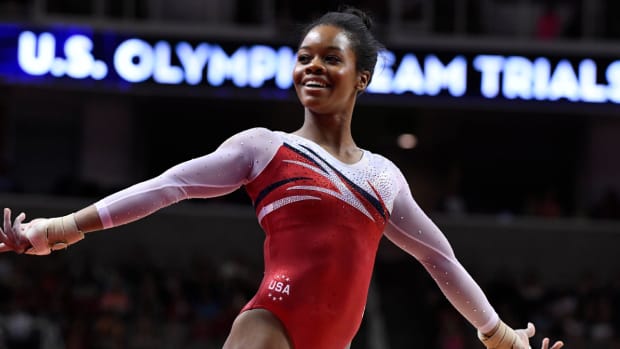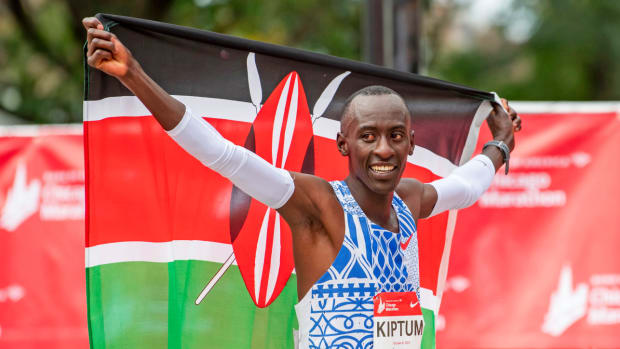After the podium, off the ice: Olympic silver medalist Sasha Cohen opens up
I’m writing this essay in the spare moments I find between assignments. It’s a Tuesday afternoon, and I work at 60 Minutes in New York City as part of the highly sought-after CBS News Associates Program that gives aspiring journalists a chance to build a career in news. I’ve traded in my Olympic dream for a new dream, of traveling the globe to interview the individuals who shape our society and fill our newspapers. Charlie Rose and Lesley Stahl have now replaced Kristi Yamaguchi and Scott Hamilton as my idols. Sure, it’s lofty and unlikely, but aren’t dreams supposed to be?
You might say that my life has slowed down since my Olympic days. I suppose that’s the nature of an office job, a drastic shift from my old life flying around the world and flying around the ice with the equivalent of quarter-inch knives strapped to my feet. Those days were packed with training sessions, interviews, photo shoots and red carpet events. Every day was a competition—sometimes literally—against the standard I had set the day before.
The last time I competed, I was finally able to describe the feeling I got before stepping out on the ice at a world championships: overwhelming nausea, weakness in my limbs and a thousand pounds of pressure crushing my chest. The only solution was to smile, deny my fear and skate to the center of the ice. Before every competition, I asked myself why I subjected myself to this torture, secretly considering never doing it again.
But as the music began and I started my initial choreography, the nerves would fade with each jump landed, replaced by pure elation. By the time I finished my program, I couldn’t wait to do it again. I lived for the connection with a roaring crowd after a satisfying performance and for the chance of seeing an elusive 6.0 from the judges. I anticipated and craved the immediate relief of sitting in the “Kiss and Cry” area while the next competitor nervously warmed up, avoiding the flying teddy bears and flowers that littered the ice. That was normal.
•Read all ofSports Illustrated’s best Where Are They Now? stories
Competitive life was all-consuming. I spent my childhood and teenage years with a singular motivation: becoming an Olympian. It was lonely and pressure-packed. I lived in a world of my own thoughts, intensified by my expectations. I marked my calendar with competitions, precisely crafted training regimens and weeks of choreography to kick off a new season in preparation for the next national and world championships.
In individual sports, accountability takes on extra significance. An athlete’s career isn’t made or broken by anyone else. Success is defined by what you will commit, what you will sacrifice and most importantly, what you will endure. The results are direct and immediate. You’re as good as your last performance, and you can change your life in four minutes. Where else does that happen?
The world is a chaotic place, but every four years when the Olympic flame is lit, a sense of connection is born. It’s pure magic. For me, it was captured in the excited buzz of foreign languages spoken at the Olympic Village, the global media frenzy, and the friendships I made with people like me, who wouldn’t think twice about trading a normal life for the chance to be an Olympian.
As an Olympic hopeful, my world was small. Only my coach and my mom were on the inside, and we prepared for the 2002 and ’06 Olympics together. I wasn’t expected to make the ’02 team after being sidelined the previous year with a broken back, so we were giddy with excitement for the chance to go to Salt Lake City. All of my family flew out from California to support me. I finished fourth, just off the podium, but I wasn’t fazed. I was more determined than ever to renew my commitment to skating and pursue my dreams for gold at the next Olympics. Going into 2006, my team realized the Turin Games would most likely mark the end of my competitive career and life as we knew it. It weighed on all our shoulders. There would be no gold, but there was a miraculous silver—even after I fell twice in the first 35 seconds of my long program. But that’s another story. That life is over, but only because that chapter closed am I able to live the next one.
Photos: Olympic silver medalist Sasha Cohen, then and now
As you might imagine, competitive life didn't leave me much time to fully develop personally or experience the many rites of passage that those in the normal world go through, like prom, joining a sorority or summer backpacking. When I competed I was constantly resting between practices, in bed early and visualizing my next performance as I fell asleep. I didn't have the bandwidth or desire to be involved in the social fabric of life. I couldn’t believe what my first year of retirement was like: Without the stress and mental weight of upcoming competitions, life felt like a permanent vacation. I could now enjoy the Fourth of July instead of being the only one training at the rink and running sprints at the track. I could go to bed late, eat pasta and simply goof off with my friends at the rink. It seemed too good to be true—and it was, because it came with a price.
I lost the clarity of focus that accompanied my days as an amateur athlete. Where else was I going to find that adrenaline, connection and sense of purpose? Adjusting to my new normal was—and still is—difficult. If you came of age in a world outside of sports, you know that the normal world doesn’t work this way. For me, it was quite the surprise.
I joined a long list of retired Olympians out of the spotlight—athletes like myself who had given everything to their sport and the pursuit of Olympic gold and glory only to see their years of sacrifice reduced to no more than an interesting topic of conversation. I think the most frustrating part of the transition was that the skills I had spent 20 years developing weren't exactly transferable to a world outside sports.
So with my ice skating days behind me, I’m finally exploring the parts of me that I never knew existed when my entire mental capacity was directed towards my Olympic dream. Change is never easy, but it provides the shift in mindset necessary for growth. I have had to start over, acquire new credentials, and advance all over again. All my life experience up to the age of 26 told me I could throw my body at a problem. I mean that literally: Skate faster, jump higher, train harder, ignore any whisper of fear or tinge of pain and fly. That’s how I learned all my jumps. That was my conditioning.
I had to be “broken in” to living a real life: managing a bank account, finding an apartment, getting healthcare and filing my tax returns. During my skating days, I had a sort of immunity from all that. Growing up, I only worried about climbing trees, outrunning the boys and winning as many medals as possible. Basically, I crave adrenaline-driven excitement, which makes it difficult to plug into the real world. Those who know me think I’m a daredevil with no regard for physical pain, and that I live life on a precipice. It’s true—I’ve been that way since I could crawl. Even in an elementary school setting, fitting in wasn’t easy. I used to do cartwheels during roll call outside, or refuse to put away my art project because “I wasn’t done yet,” even though it was time for math. One elementary school teacher thought I was deaf because I never listened to any instructions, and another gave my parents a book about how to handle future juvenile delinquents.
That in mind, let’s fast-forward 20 years. Throwing your body at problems isn’t going to get you anywhere on a college campus. I trained myself to sit still, pay attention to the small details and take notes. I finally learned what a thesis was and why every professor was so adamant that I include one in a paper. It was a struggle, I can assure you. I had to get used to the rules and standard procedures by which the rest of the world lived. For an individual athlete, there are no standard procedures. The world I knew was hand-tailored to my needs by a team of coaches, choreographers, private tutors, managers, physical therapists and publicists.
My transition to that new life began with my application to Columbia University at 25: standardized tests, structured essays, mandatory deadlines. I started with two to three classes a semester and continued to train daily and tour on weekends. Going to college was the greatest gift I could have ever given myself. I fell in love with German philosophy, Romantic poetry and American history. School felt like a luxury after spending so many years pent up in an ice rink: reading on Columbia’s iconic steps at Low Library, discussing the Greek Stoics at Joe’s Coffee and sharing pre-college life stories with other General Studies students.
As much as I loved learning, after sitting for a total of two and a half hours in back-to-back classes I was fidgety and ready for a run, a stretch and a breath of fresh air. I could not process that I would have to sit for another five or six hours of reading that very same day. For years of my life, sitting was reserved for the ride to the rink and for meals between workouts. I had to adjust to a complete reversal, and it wasn’t easy. I’m pleased to say that upon graduation, I was a modestly successful sitter—a fundamental building block for “normal” life.
I guess it was time, because things have seriously slowed down since my competitive days. It happens to most athletes leaving the sports world, and I’m no exception. I felt my morale and confidence drop as the real world humbled me. O.K., no problem. I can start again ... as long as I know where I’m going. But people keep telling me that’s not how the real world works. The path won’t be revealed to you before the start. There are few goals as difficult as making it to the Olympics and representing your country in a sport you love, but there are also few goals as clear.
After losing his legs shortly after birth, Hunter Woodhall found his place on the track
If there is a “why”, the resilient spirit in us can manifest a “how”. So I’m looking for my “why”. I want to share my experiences and learn from others. That’s what attracted me to journalism: the potential to live on the crest of world events as they unfold and to share the stories of people who have experienced a defining challenge or life event.
For better or worse, we live in a world where people don’t get many chances to connect at a level beyond screens, sound bites and Instagram highlights. I have attempted to offer a glimpse of the humanity behind your Olympic heroes—the struggle we face to adapt and to find meaning in a new life. More than ever, people need to hear about that struggle: to be flawed, to be human and to grow. My hope is that the world (myself included) will embrace the discomfort and social stigma of being vulnerable in a culture that naïvely associates it with weakness. In reality, vulnerability allows people to be authentic, connect with others and embrace their personal truths.
I felt I never had that enlightened awareness as an athlete: I admitted nothing, I denied any murmur of insecurity, I gave politically correct answers at press conferences, I cultivated an image, I hid my humanity. It was necessary for the competitor, but it is destructive for the human being. Perhaps the most vital part of my transition has been to let down my guard, accept mistakes as a form of progress, and to know that I don't need to have all the answers today.





